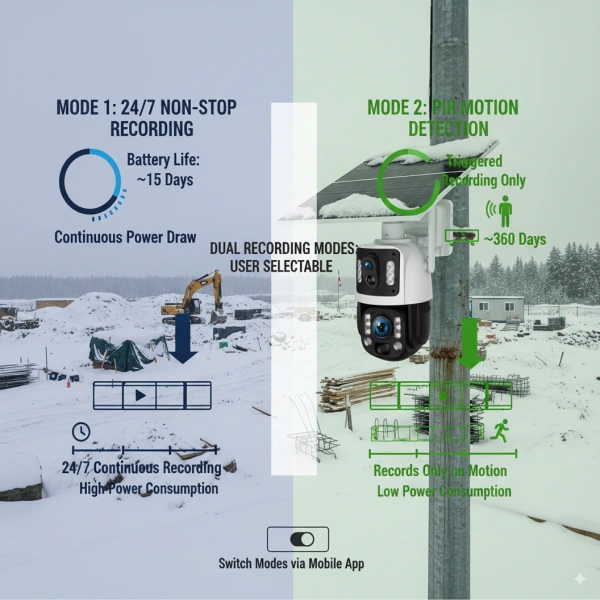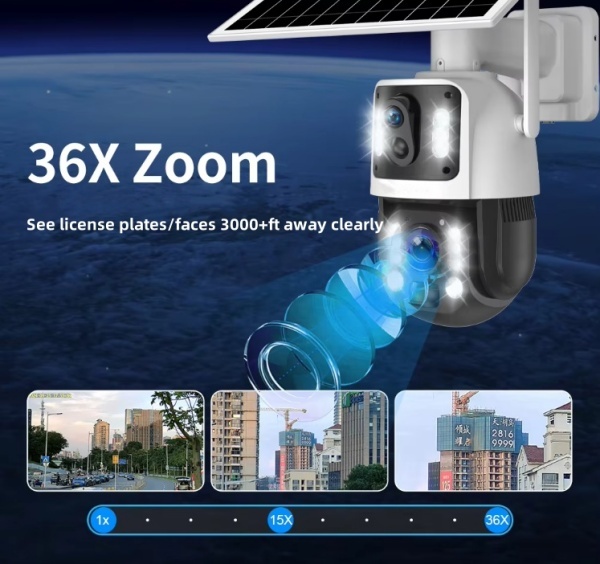Off-Grid Surveillance: The Power of PTZ Solar Cameras
PTZ Solar Cameras: The Power of Remote Control and 360-Degree Surveillance
In 13 years of designing solar security cameras, I’ve seen one recurring challenge for businesses: blind spots. A single fixed camera, no matter how high the resolution, creates a permanent blind spot behind it. To cover a large construction site, farm, or parking lot, companies are forced to install numerous cameras, leading to skyrocketing costs in hardware, installation, and maintenance. This is the fundamental limitation that Pan-Tilt-Zoom (PTZ) solar cameras were engineered to solve.
Traditional surveillance systems chain you to a fixed view. PTZ cameras break those chains. They offer dynamic, active monitoring, allowing you to control the camera’s perspective remotely. By combining pan, tilt, and zoom functionalities with the off-grid power of solar energy, you gain unparalleled control over your security, eliminating the need for multiple fixed units and providing comprehensive, 360-degree coverage without dead zones.
What Makes a PTZ Solar Camera Tick? The Engineering Behind Remote Control
A PTZ solar security camera isn’t just a camera on a moving mount; it’s an integrated system of precision mechanics, power management, and wireless communication. Understanding these components is key to appreciating its value for your business.
The “PTZ” acronym stands for:
- Pan: The ability for the camera to swivel horizontally, typically up to 355 degrees. This allows you to survey a wide panoramic area.
- Tilt: The vertical movement, usually around 90-120 degrees. This lets you look up and down, covering ground level and higher elevations.
- Zoom: This is arguably the most critical feature. True professional-grade PTZ cameras use optical zoom, where the lens physically adjusts to magnify a subject without losing image quality. This is vastly superior to digital zoom, which simply enlarges pixels and results in a blurry image.
This entire system is powered by a carefully balanced solar panel and battery combination. Our designs incorporate a sophisticated Battery Management System (BMS), a crucial technology that protects the battery from overcharging and deep discharging, ensuring reliable performance through cloudy days and extending the product’s lifespan. Connectivity via 4G or a long-range wireless camera system is what enables the real-time remote control from anywhere in the world.
Fixed vs. PTZ Solar Cameras: A Head-to-Head Comparison
For distributors, installers, or brand owners, understanding the distinct advantages of a PTZ camera is crucial for advising clients. While fixed cameras have their place, PTZ models offer a superior return on investment for large-area surveillance. Here’s a direct comparison of the core differences.
| Feature | Fixed Solar Camera | PTZ Solar Camera |
|---|---|---|
| Coverage Area | Limited, static field of view (e.g., 90-120°) | Expansive, dynamic 360° coverage |
| Blind Spots | Significant, requiring multiple units for overlap | Virtually eliminated with a single unit |
| Remote Control | None (view only) | Full pan, tilt, and optical zoom control |
| Incident Investigation | Passive recording of what’s in view | Active tracking and zooming in on subjects |
| Initial Cost (per area) | Lower per unit, but higher total cost for large areas | Higher per unit, but lower total cost for large areas |
| Ideal Application | Entrances, specific assets, small yards | Construction sites, farms, parking lots, open-pit mines |
The choice is clear: for any application requiring surveillance of more than a single, fixed point, a PTZ solar camera offers dramatically more value and security.
Case Study: Securing a 10-Acre Logistics Yard
A tangible example highlights the transformative impact of PTZ technology for businesses like logistics providers and construction site managers.
- Problem: A logistics company in a rural area with no grid power or wired internet needed to secure its 10-acre equipment yard. They were experiencing frequent theft of fuel and small tools. An initial quote using 8 fixed solar cameras was expensive and still left significant coverage gaps between containers and machinery.
- Solution: We proposed a strategic deployment of two UBOXCAM 36x optical zoom 4G solar PTZ cameras mounted on 20-foot poles at opposite corners of the yard. This provided overlapping fields of view and the ability to monitor the entire perimeter and interior. The 4G connectivity allowed their central security office, located 50 miles away, to have full control.
- Result: With just two cameras, the company achieved 98% coverage of the yard. The initial hardware and installation cost was reduced by 55% compared to the 8-camera plan. In the first three months, operators used the PTZ function to track and identify an unauthorized vehicle, leading to an arrest. Reported thefts dropped to zero, and the client estimated a 30% reduction in security-related operating costs due to fewer required on-site patrols.
This demonstrates how PTZ cameras don’t just record events; they empower active prevention and response, a key selling point for your B2B customers.
Troubleshooting Common PTZ Camera Issues
As an engineer, I believe in providing practical solutions. Whether you’re an installer or an end-user, here are answers to common operational questions about PTZ solar cameras.
- The camera’s PTZ movement is jerky or unresponsive. What’s the cause?
First, check the 4G/WiFi signal strength indicator in your app. A weak or unstable connection is the most common culprit. Second, ensure the camera’s battery level is above 20%; low power can limit motor function. Finally, a simple remote reboot via the app can often resolve temporary software glitches. - Why does the image become pixelated when I zoom in?
This happens when you are using digital zoom beyond the camera’s optical zoom limit. Always prioritize models with higher optical zoom (e.g., 20x, 36x). At UBOXCAM, we focus on high-quality lens assemblies to ensure clarity even at maximum magnification, which is essential for identifying license plates or faces. - My camera’s “auto-tracking” feature is too sensitive and follows falling leaves. Can I adjust it?
Yes. Professional-grade cameras integrate AI-powered human and vehicle detection. This allows you to set the auto-tracking to only trigger when a person or car is detected, ignoring irrelevant motion. Check your app’s alarm settings to fine-tune this feature for optimal performance.
Future Trends: AI-Powered PTZ and Beyond
The technology is constantly evolving. The next frontier for PTZ solar cameras is deeper integration with Artificial Intelligence. We’re moving beyond simple motion detection to sophisticated AI algorithms that enable features like:
- Predictive Auto-Tracking: The camera anticipates a subject’s path for smoother tracking.
- Automated Guard Tours: Set pre-defined “patrol” routes where the camera automatically pans, tilts, and zooms to specific points of interest at scheduled times.
- Object Identification: Differentiating between a person, a vehicle, and an animal, and triggering different alerts for each.
As a B2B partner, offering cameras with these advanced features will position your brand as a technology leader. The demand for intelligent, autonomous surveillance in off-grid locations like building sites and for environmental monitoring is growing exponentially.
A Practical Checklist for Selecting the Right PTZ Solar Camera
Use this checklist to guide your purchasing decisions or to help your clients choose the perfect model for their needs. This ensures you invest in a solution that delivers results, not headaches.
✓Assess the Area Size: For areas up to 2 acres, a 20x optical zoom may suffice. For larger areas like farms or industrial sites, a 30x or 36x zoom is necessary.✓Verify Power Autonomy: Check the solar panel wattage and battery capacity (measured in Ah). A well-engineered system should operate for at least 3-5 days without any direct sunlight. This is directly related to the BMS quality.✓Confirm Connectivity: Test the 4G signal strength at the intended installation site using a standard smartphone. If the signal is weak, consider a model with an external high-gain antenna.✓Demand Optical Zoom: Do not compromise. Insist on optical zoom for clear identification at a distance. Ask the supplier for the lens specifications.✓Check for IP Rating: For outdoor use, an IP66 rating is the minimum standard, ensuring protection against dust and powerful jets of water.✓Evaluate the Software: The user app should be intuitive, stable, and offer granular control over PTZ speed, preset positions, and alert settings.
By investing in a high-quality PTZ solar camera, you are not just buying hardware; you are investing in peace of mind and operational efficiency. For wholesalers, distributors, and Amazon sellers, offering a robust, feature-rich PTZ camera is a powerful differentiator. Contact the UBOXCAM engineering team today to discuss your customization needs and get a quote for your next project.
Key Takeaways: The PTZ Advantage
To summarize, the value of PTZ solar cameras for B2B applications is multifaceted and compelling.
| Advantage | Business Impact |
|---|---|
| Complete Coverage | Eliminates blind spots and reduces the number of cameras needed, lowering total project cost. |
| Remote Control | Enables active security monitoring and incident response from anywhere, improving efficiency. |
| Optical Zoom Clarity | Provides actionable evidence by allowing clear identification of faces, license plates, and details. |
| Off-Grid Capability | Unlocks surveillance for remote sites (farms, construction, infrastructure) without power or internet. |
The ability to remotely control a camera and see an entire area in detail is no longer a luxury—it’s a modern security necessity. By partnering with an experienced manufacturer like UBOXCAM, you can provide your clients with powerful, reliable, and cost-effective surveillance solutions that directly address their biggest security challenges.


